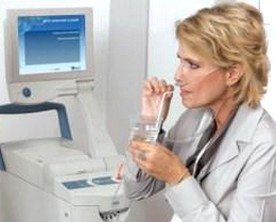Soluk testiyle kolorektal kanser teşhisi mümkün hale geliyor!
 British Journal of Surgery’de yayınlanan yeni bir çalışmada, basit bir soluk analizinin kolorektal kanser taramasında kullanılabileceği gösterildi. Kanser dokusunun normal sağlıklı hücrelere göre farklı metabolizması vardır ve bu hastaların soluğunda saptanabilecek bazı maddeler üretmektedir. Kanser ile bağlantılı uçucu organik bileşiklerin (VOC) analizi, kanser taramasında yeni bir sınırdır. Çalışmanın sonuçlarına göre, soluk numunelerinde 15/58 spesifik bileşenin analizinde, kolorektal kanserli hastaların, sağlıklı kontrollere göre farklı bir VOC paterni olduğu saptanabiliyor.
British Journal of Surgery’de yayınlanan yeni bir çalışmada, basit bir soluk analizinin kolorektal kanser taramasında kullanılabileceği gösterildi. Kanser dokusunun normal sağlıklı hücrelere göre farklı metabolizması vardır ve bu hastaların soluğunda saptanabilecek bazı maddeler üretmektedir. Kanser ile bağlantılı uçucu organik bileşiklerin (VOC) analizi, kanser taramasında yeni bir sınırdır. Çalışmanın sonuçlarına göre, soluk numunelerinde 15/58 spesifik bileşenin analizinde, kolorektal kanserli hastaların, sağlıklı kontrollere göre farklı bir VOC paterni olduğu saptanabiliyor.
Aldo Moro Üniversitesinde Acil Tıp ve Organ Nakli merkezinden Prof. Dr. Donato F. Altomare önderliğindeki araştırmacılar, kolorektal kanserli 37 hastanın ve 41 sağlıklı kontrolün verdiği soluğu toplamıştır. Toplanan numuneler VOC profilinin değerlendirilmesi için offline olarak incelenmiştir. İlgili VOC değerleri tanımlanmış ve seçilmiştir ve VOC paternleri ile hastalar kontrol grubundan ayırt edilebilmiştir.
Kan testlerini unutun, hastalıkları nefesle teşhis eden elektronik burun geliyor!
Olasılıklı sinir ağı (PNN) iki grup arasında daha iyi ayrım yapan VOC değerleri paternini tanımlamak için kullanılmıştır. Sonuçlar, verilen soluk numunelerinde 15/58 spesifik bileşenin analizine dayanılarak, kolorektal kanserli hastaların, sağlıklı kontrollere göre farklı bir seçici VOC paterni olduğunu gösterdi.
Bu çalışmadaki PNN, düzgün şekilde 19 hasta atayan model ile, %75’in üzerinde bir doğruluk oranıyla kolorektal kanserli hastaları ayırt edebilmiştir. Çalışmayı değerlendiren Prof. Dr. Altomare, “Soluk numunesi alımındaki teknik çok kolaydır ve invazif değildir, bununla birlikte, yöntem, hala erken gelişim fazındadır. Çalışmamızın bulguları, soluk testi değeri için tarama aracı olarak daha fazla destek sunmaktadır” dedi.
Kaynak: Exhaled volatile organic compounds identify patients with colorectal cancer. D. F. Altomare, M. Di Lena, F. Porcelli, L. Trizio, E. Travaglio, M. Tutino, S. Dragonieri, V. Memeo, G. De Gennaro. British Journal of Surgery, 2012; DOI: 10.1002/bjs.8942Makalenin tam metnine aşağıdaki linkten ulaşılabilmektedir:
http://www.ncbi.nlm.nih.gov/pubmed/23212621
Abstract
BACKGROUND: An effective screening tool for colorectal cancer is still lacking. Analysis of the volatile organic compounds (VOCs) linked to cancer is a new frontier in cancer screening, as tumour growth involves several metabolic changes leading to the production of specific compounds that can be detected in exhaled breath. This study investigated whether patients with colorectal cancer have a specific VOC pattern compared with the healthy population.
METHODS: Exhaled breath was collected in an inert bag (Tedlar(®) ) from patients with colorectal cancer and healthy controls (negative at colonoscopy), and processed offline by thermal-desorber gas chromatography-mass spectrometry to evaluate the VOC profile. During the trial phase VOCs of interest were identified and selected, and VOC patterns able to discriminate patients from controls were set up; in the validation phase their discriminant performance was tested on blinded samples. A probabilistic neural network (PNN) validated by the leave-one-out method was used to identify the pattern of VOCs that better discriminated between the two groups.
RESULTS: Some 37 patients and 41 controls were included in the trial phase. Application of a PNN to a pattern of 15 compounds showed a discriminant performance with a sensitivity of 86 per cent, a specificity of 83 per cent and an accuracy of 85 per cent (area under the receiver operating characteristic (ROC) curve 0•852). The accuracy of PNN analysis was confirmed in the validation phase on a further 25 subjects; the model correctly assigned 19 patients, giving an overall accuracy of 76 per cent.
CONCLUSION: The pattern of VOCs in patients with colorectal cancer was different from that in healthy controls. The PNN in this study was able to discriminate patients with colorectal cancer with an accuracy of over 75 per cent. Breath VOC analysis appears to have potential clinical application in colorectal cancer screening, although further studies are required to confirm its reliability in heterogeneous clinical settings.
YAZIYI PAYLAŞ


 British Journal of Surgery’de yayınlanan yeni bir çalışmada, basit bir soluk analizinin kolorektal kanser taramasında kullanılabileceği gösterildi. Kanser dokusunun normal sağlıklı hücrelere göre farklı metabolizması vardır ve bu hastaların soluğunda saptanabilecek bazı maddeler üretmektedir. Kanser ile bağlantılı uçucu organik bileşiklerin (VOC) analizi, kanser taramasında yeni bir sınırdır. Çalışmanın sonuçlarına göre, soluk numunelerinde 15/58 spesifik bileşenin analizinde, kolorektal kanserli hastaların, sağlıklı kontrollere göre farklı bir VOC paterni olduğu saptanabiliyor.
British Journal of Surgery’de yayınlanan yeni bir çalışmada, basit bir soluk analizinin kolorektal kanser taramasında kullanılabileceği gösterildi. Kanser dokusunun normal sağlıklı hücrelere göre farklı metabolizması vardır ve bu hastaların soluğunda saptanabilecek bazı maddeler üretmektedir. Kanser ile bağlantılı uçucu organik bileşiklerin (VOC) analizi, kanser taramasında yeni bir sınırdır. Çalışmanın sonuçlarına göre, soluk numunelerinde 15/58 spesifik bileşenin analizinde, kolorektal kanserli hastaların, sağlıklı kontrollere göre farklı bir VOC paterni olduğu saptanabiliyor. Kolorektal kanserlerin belirtileri, teşhisi ve güncel tedavi seçenekleri
Kolorektal kanserlerin belirtileri, teşhisi ve güncel tedavi seçenekleri Metastatik kanserlerde hedefe yönelik tedavi seçenekleri artıyor
Metastatik kanserlerde hedefe yönelik tedavi seçenekleri artıyor Kan testiyle Alzheimer teşhisi mümkün hale geliyor
Kan testiyle Alzheimer teşhisi mümkün hale geliyor Artesunat kombinasyonunun kolorektal kanser tedavisine etkisi var mı?
Artesunat kombinasyonunun kolorektal kanser tedavisine etkisi var mı? Covid-19: Koronavirüs testleri, tedavisi ve aşı çalışmaları
Covid-19: Koronavirüs testleri, tedavisi ve aşı çalışmaları
YORUMUNUZ VAR MI?